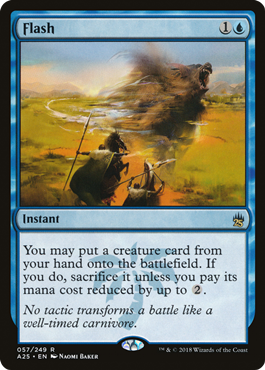While Commander’s grassroots origins make it different from many other Magic formats, it still has a ban list like the rest of them. However, since Commander is not a competitive format with tournament data to back up banning certain cards, some players are unsure why certain offenders end up on the list. Today, we’re going to take a look at Flash and examine its history, why it’s banned in Commander and whether it would be safe to take it off the list.
Flash is an Instant from 1996’s Mirage that puts a creature card from your hand onto the battlefield. Then, you have to pay the cost of that card minus two generic mana. If you don’t, that creature gets sacrificed.
Why Is Flash Banned in Commander?
At first glance, Flash might just seem like it can give a creature a convoluted version of…well…Flash! In fact, this is where the evergreen keyword gets its name. However, only part of Flash’s power comes from the fact that it lets you put a creature into play at Instant speed.
More importantly, it allows you to abuse powerful creatures with abilities that trigger when they enter the battlefield or die. You can simply put them into play with Flash and neglect to pay its actual cost.
To fully understand why Flash is banned in Commander, we have to look at its broader history as a completely busted card in other formats. After all, Flash’s story as a broken card began way back in 1999, when Commander was but a twinkle in Sheldon Menery’s eye.
That year, two cards from Urza’s Destiny made it clear that Flash was a serious problem: Academy Rector and Yawgmoth’s Bargain. You could Flash the Rector into play on turn two and sacrifice it. Then, when the Rector went to the graveyard you would grab your Bargain and put it directly on the battlefield.
A turn two Bargain was pretty close to unbeatable. For the first time, it became clear that Flash was far too easy to abuse.


Interestingly enough, the response to this combo was not banning Flash. Instead, they decided to issue a power level errata. In those days, when an old card suddenly became powerful because of new cards or a rule change, Wizards often responded by changing the text of the card instead of banning it. In 1999, Flash’s text was changed to:
“Choose a creature card in your hand. You may pay its mana cost reduced by up to 2. If you do, put that card into play. If you don’t, put that card into your graveyard.”
In other words, Flash wouldn’t put the creature in play unless you paid its mana cost minus two generic mana. Otherwise, you effectively discard the card.
This change remained in place until May 15th, 2007, when its original functionality was restored. By that point, the philosophy around cards becoming busted had shifted entirely toward banning.
Just four days after its official functionality was restored, Flash broke the Legacy format at Grand Prix Columbus. Now, Flash could be combined with Protean Hulk for an instant-win combo — and this could be done on turn one with Legacy’s fast mana.
When you Flash in the Hulk and let it die, you could search your library for any number of creatures with a mana value of six or less and put those creatures into play. This allowed you to easily construct multi-card combos that could win the game on the spot.
After Flashing in the Hulk and letting it die, you would search up Karmic Guide and Carrion Feeder. The Guide would reanimate the Hulk, which you would then sacrifice to Carrion Feeder to get another trigger. This time, you grabbed Kiki-Jiki, Mirror Breaker.
From here, you would use Kiki-Jiki’s ability to Karmic Guide and sacrifice Kiki to Carrion Feeder in response, which you would then reanimate with the Guide’s ability. Kiki could then make another Karmic Guide, and you could keep the loop going until you had a million Karmic Guides to attack for lethal.



This is just one of the many combos that were possible in Flash Hulk decks. After its functionality was restored, Flash was legal for exactly one Legacy event before being banned in the format. It was also subsequently restricted in Vintage.
However, it was not immediately banned in Commander! Instead, Protean Hulk got banned in 2008. So while the Flash Hulk combo was impossible, other Flash shenanigans were not.
Then, in 2017, the Hulk was unbanned and Flash Hulk was once again possible in Commander. However, in 2020, Flash finally ended up on the ban list, breaking up the combo once again.
This ban was somewhat controversial, as it was banned as a result of the presence of Flash Hulk decks in cEDH (competitive EDH). People who play competitive Commander are a pretty small segment of the community, but the Flash Hulk combo was warping the format so much that something had to be done.
Should Flash Be Unbanned?
No, it shouldn’t. As we’ve seen in this article, Flash is very easy to abuse — and not just in competitive EDH. While combining it with Protean Hulk is the most busted thing of all, the fact it can be combined to great effect with virtually any card with a powerful death or enter the battlefield trigger is a serious problem, and one that would continually come up as new cards are printed.
If Flash wasn’t banned, cards like Protean Hulk would have to be, just like it was between 2008 and 2017. And instead of banning a whole bunch of interesting creatures, it is better to simply ban Flash, which allows those cards to go off in the extreme early game.
End Step
That’s all for today. I’ll be back next week to discuss another card that is banned in Commander! You can hit me up on Twitter (@NizzahonMagic) for other cards you want to see in this series.

Jacob has been playing Magic for the better part of 24 years, and he especially loves playing Magic’s Limited formats. He also holds a PhD in history from the University of Oklahoma. In 2015, he started his YouTube channel, “Nizzahon Magic,” where he combines his interests with many videos covering Magic’s competitive history. When he’s not playing Magic or making Magic content, he can be found teaching college-level history courses or caring for a menagerie of pets with his wife.



